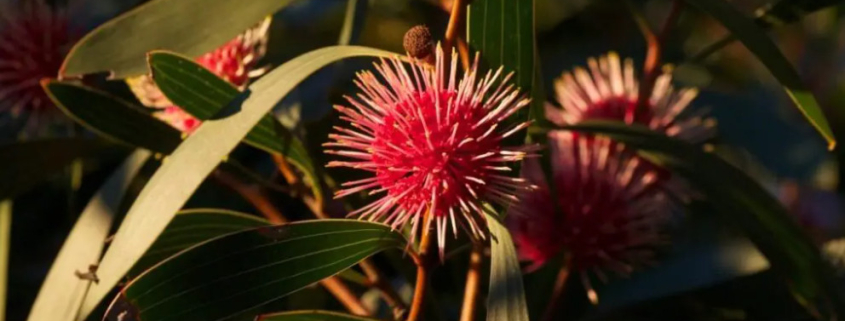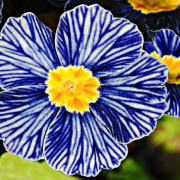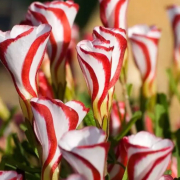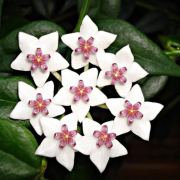Hakea Laurina (Pincushion Hakea): Description, Types & Caring
Hailing from Western Australia, Hakea Laurina, often called the “Pincushion Hakea“, stands as a testament to nature’s artistry and resilience. With spherical blossoms characterized by a reddish-pink center, tipped with white or cream-colored protruding styles, these flowers truly resemble pins emerging from a cushion.
Complemented by lance-shaped, deep green leaves, the overall aesthetic of the Hakea Laurina is undeniably striking. Beyond its beauty, this plant offers versatility and endurance, making it a favored choice for gardens in varied climates.
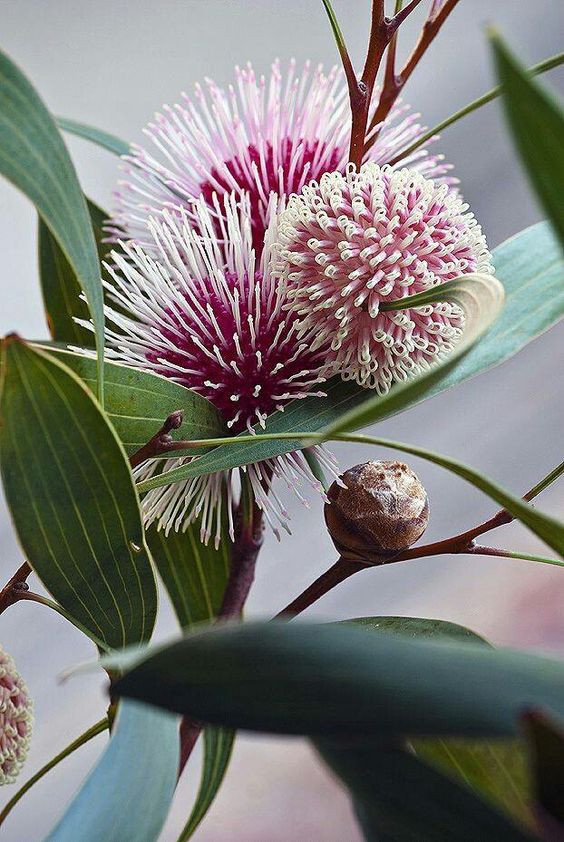


Types of Hakea
The Hakea Laurina is undoubtedly a standout in the diverse Hakea genus, but it’s essential to recognize that the genus itself is brimming with intriguing varieties, each bringing its unique charm and characteristics. Here’s an extended exploration of some of the notable types of Hakea:
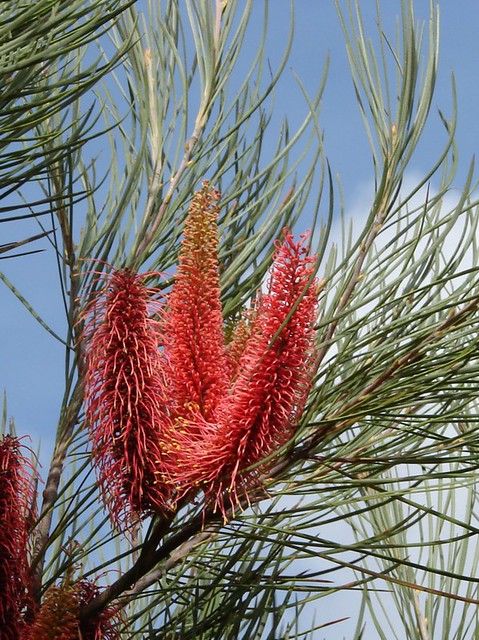
Hakea Buculenta
This species stands out primarily because of its captivating long red flowers. These blooms often become the focal point in gardens, especially when they’re in full bloom during the winter season. Additionally, its intricate leaf pattern adds to its visual appeal, making it a favorite among many horticulturists.
Hakea Sericea
Also known as the “Silky Hakea,” Hakea Sericea is easily recognized by its distinct needle-like foliage. This dense foliage not only provides an attractive green backdrop in gardens but also acts as a haven for various bird species. When it blooms, this variety produces beautiful clusters of white flowers, adding a contrast to its spiky leaves.


Hakea Prostrata
As the name suggests, Hakea Prostrata tends to grow horizontally, making it an excellent ground cover. For those with vast garden spaces or those who wish to cover specific ground patches with vibrant flora, this variety is a top choice. In addition to its spread, the Hakea Prostrata showcases a profusion of small, fragrant flowers during its blooming season.
Hakea Cucullata
This variety is renowned for its hood-shaped leaves, giving it the moniker “Hood-leaved Hakea“. Its flowers, however, are the real showstopper. The blooms are typically pink to reddish, and their sweet nectar often attracts an array of birds and bees, making gardens come alive with activity.
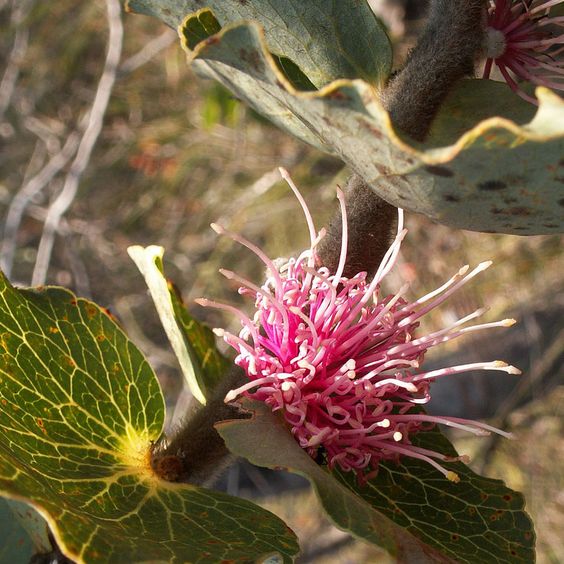

Hakea Orthorrhyncha
Often referred to as the “Bird-beak Hakea,” this type is identified by its elongated and curved seed pods, resembling a bird’s beak. It’s an upright shrub, producing striking red or pink flowers during the winter months.
With such diverse varieties within the Hakea genus, gardeners and plant enthusiasts have a plethora of options to choose from, ensuring that their gardens always have a touch of unique beauty and vibrancy.
Planting Hakea: Steps to Success
- Location: Hakea Laurina’s adaptability shines in its ability to flourish under a variety of lighting conditions. While it thrives best in full sun, it’s also tolerant of partial shade. Depending on your garden’s orientation, choose a spot that offers a blend of these conditions for optimal growth.
- Soil Requirements:
- Type: This plant isn’t overly fussy about its soil but has a preference for well-draining types.
- Composition: Enhancing your garden soil with a blend of sand, compost, and traditional garden soil creates an ideal environment for its roots.
- pH Level: Hakea Laurina tends to thrive in neutral to slightly acidic soils.
- Spacing:
- For individual plants, allow room for growth by providing ample space.
- For those aiming to cultivate a Hakea Laurina hedge, spacing the plants about 1.5 to 2 meters apart ensures they grow to form a dense barrier.
- Watering:
- Initial Phase: Newly planted specimens demand consistent watering until they establish.
- Mature Phase: Once settled, they showcase their drought-resistant trait, requiring infrequent watering.
Care Tips: Ensuring a Flourishing
- Pruning:
- Frequency: Regular trimming is beneficial, particularly post-flowering season.
- Purpose: This not only promotes denser growth but, for those cultivating a hedge, maintains a neat and structured appearance.
- Fertilizing:
- Opt for a slow-release, low-phosphorus fertilizer.
- Timing: The onset of spring is ideal, ensuring your Hakea Laurina gets the nutrients it needs for healthy growth and an abundance of blossoms.
- Pest Management:
- Natural Resistance: One of the advantages of this plant is its inherent resistance to many pests.
- Vigilance: However, keep an occasional eye out for aphids or scale. Employ natural predators like ladybugs or treatments like insecticidal soap for control, ensuring minimal environmental impact.
- Mulching:
- Material: Organic mulches, such as straw, bark, or compost, are recommended.
- Benefits: Mulching helps in moisture retention, weed suppression, and provides a steady supply of organic matter to the soil as it decomposes.
Size
The dimensions of a plant play a crucial role in determining its fit within a garden. As such, understanding the size and growth tendencies of Hakea Laurina can aid gardeners in making informed decisions that align with their landscaping visions.
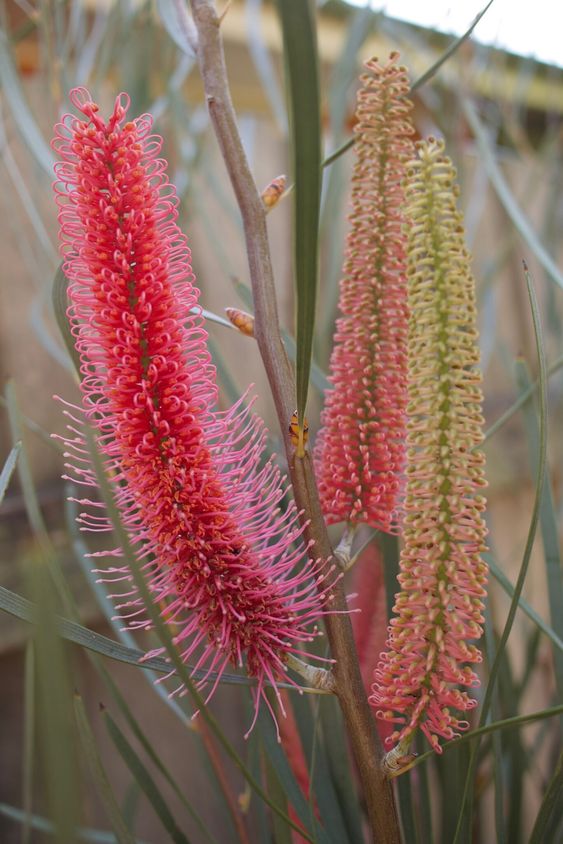
Height
One of the standout characteristics of Hakea Laurina is its variable height. On average, this plant reaches a height range of 2.5 to 6 meters. This range positions Hakea Laurina as a medium-sized shrub, but in certain optimal conditions, it can also flourish as a small tree. Given its height, it’s versatile enough for both residential gardens, where space might be limited, and more expansive landscapes.
Spread
Equally important to its height is the plant’s spread. Hakea Laurina extends roughly as wide as it is tall, making it a full-bodied addition to any garden. This symmetrical growth habit ensures that, as the plant matures, it fills out spaces uniformly. For gardeners aiming to establish a robust hedge or screen, Hakea Laurina is exemplary. Its dense foliage ensures that the Hakea Laurina hedge not only stands as a visual delight but also as a functional barrier, offering both aesthetics and much-needed privacy.

Growth Rate
Hakea Laurina possesses a moderate growth rate. While it isn’t the fastest-growing plant in the gardening world, its steady development ensures that, over time, gardeners can witness a transformation in their landscape. Its growth rate also allows for easier maintenance since gardeners can predict its size progression and plan their garden layout accordingly.
Final Thoughts
Whether you’re looking to create a focal point in a small garden patch, design a natural barrier, or add a touch of Western Australian beauty to a broader landscape, understanding the growth dimensions of Hakea Laurina ensures you can make the most of this plant’s potential.
Origin of Hakea Laurina
The Laurina Hakea, scientifically known as Hakea Laurina, has its roots deeply embedded in the vast landscapes of Western Australia. This region, known for its diverse ecosystems and unique flora, has given birth to many plants that have since fascinated botanists and garden enthusiasts alike, and Hakea Laurina is no exception. Its indigenous name and presence in the local folklore stand as a testament to its long-standing relationship with the native inhabitants of the region.
The plant’s adaptation to the climate and soil of Western Australia is evident in its drought-resistant characteristics and ability to thrive in varied soil types, from sandy terrains to clayey grounds. Historically, while the plant predominantly flourished in the wild, with the increased interaction between continents and the subsequent rise in global horticulture interests, Hakea Laurina has found its way to gardens across the world. Its unique pin-cushion like flowers, which are a significant identifier of the plant, have contributed to its popularity and intrigue, making it a sought-after addition to exotic plant collections globally.
Curiosities of the Hakea Laurina
The world of botany is full of wonders, and the Hakea Laurina, or Pincushion Hakea, is no exception. One fascinating aspect of this plant is its role in Aboriginal culture. The indigenous peoples of Australia held this plant in high esteem, not just for its ornamental beauty, but also for its medicinal properties. Traditionally, the leaves were often crushed and applied to wounds, believed to have antiseptic qualities to aid in healing.
Furthermore, while its distinctive pin-cushion flowers capture our attention, few realize that these blooms have an evolutionary purpose. The protruding styles of the flowers are not just an aesthetic marvel but are also strategically designed to facilitate bird pollination. As birds reach into the flower for nectar, their heads come into contact with the styles, transferring pollen and ensuring the plant’s propagation. This beautiful synergy between the Hakea Laurina and the avian world is a testament to nature’s intricate design and balance.

